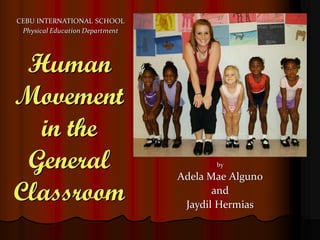
Movement in Education
- 1. CEBU INTERNATIONAL SCHOOL Physical Education Department Human Movement in the General by Adela Mae Alguno Classroom and Jaydil Hermias
- 2. Objectives : Use creative movement and dance as teaching tools in the classroom Integration of activities within the instructional day will meet the needs of a variety of learners especially kinesthetic learners in a more meaningful manner.
- 3. What to expect from the Workshop? 9:15–9:25 Powerpoint Presentation 9:25–9:45 Workshop Activity 9:45–10:05 Group Work 10:05–10:15 Group Presentation 10:15–10:20 Wrap up / Cool down
- 4. Teacher’s Flexibility in Class To meet the needs of the kinesthetic learners, teachers often add quick movement activities between lessons to allow children an opportunity for movement.
- 5. Effects of Dance on Academic Learning Werner (2001) revealed that integrating dance in math classes significantly increased positive attitudes toward math in students in second through fifth grades.
- 6. Grant’s (1985) study of the use of kinesthetic approaches to teach young children at-risk also pointed to the benefits of incorporating movement for instructional purposes.
- 7. Grant used kinesthetic approaches with first- graders to teach reading and writing skills relying heavily on motor skills and the use of gestures in addition to auditory and visual stimuli.
- 8. “Not only did the kinesthetic method prove to be more effective, but much more enjoyable for the students as well. The physical movement of this method causes such a strong attraction for the young child.”
- 9. Effects of Dance on Behavior Griss (1994) discussed the ability to take disruptive energy and make it creative. When creative energy is aligned with learning objectives, a positive environment is created. Many children who exhibit behaviors that challenge their teachers may be kinesthetic learners.
- 10. Dance is beneficial for students who have difficulty expressing themselves orally or in writing.
- 11. Effects of Dance on Assessment An additional benefit to adding movement and dance activities to the classroom involves the creation of alternate forms of assessment.
- 12. Dance represents a very expressive form of communication between a dancer and an audience. As such, it is a useful tool to evaluate the expression of a student’s understanding of class content.
- 13. Lee (1994) wrote about allowing a student to dance her understanding of class concepts. Lee’s college student was able to use her strengths to demonstrate her understanding of the differences between consultation and collaboration. The student’s performance proved to be a very powerful experience for all of the students in her class.
- 14. Teachers who have included multiple intelligence theory in their classrooms easily could add experiences such as these to allow their students new ways to demonstrate a clear understanding of their own learning.
- 15. To use dance as a legitimate form of assessment, teachers need to develop appropriate scoring rubrics aligned to standards, benchmarks, and goals. Teachers must purposefully and clearly state expected outcomes as they design rubrics so that they can objectively evaluate their students’ performance.
- 16. Table 1. Character Analysis 3 External character traits (physical attributes & actions) and internal character traits (personality, motivation, & relationships) of the character are evident and clearly portrayed through the movement phrases performed Primary complications/problems dealt with by the character are accurately portrayed through movement phrases Organization is strong and contains well developed movement phrases and transitions; themes are clear and evident Movements chosen match what they were supposed to portray 2 External character traits are evident in the movement phrases performed and some attention has peen paid to internal character traits, however the focus is on external traits The main problem in the story is evident through the movements used, but other complications are not evident Several important movement phrases are present and well sequenced, but transitions are needed Some movement chosen match what they are supposed to represent, others seem very contrived or mismatched 1 Only external character traits are present in the movements used Some aspects of the story are present in the movement phrases, but they did not contain the primary complication/problems faced by the character Sequence of movement phrases is difficult to follow and lacks clear organization Movements chosen often are not a good match for what they are supposed to represent
- 17. Topic integrated with Human Movement Insect metamorphosis lesson and observations of caterpillars and butterflies First Section: entrance to the stage- caterpillar would move heavy, indirect & slow : students perform a wringing movements with their bodies Second Section: forming of chrysalis followed by stillness Final Section: end with a way to leave the stage the way a butterfly would move – light, fast and using flicking movements as they flit across, then off the stage.
- 18. Who am I with? A B C Rae Lianne Jeralyn Khristine Rosalie Joel Clara Sandee Emily
- 19. MATH – “Counting Song” SCIENCE – “Sugar Song” ENGLISH – “Verb Song”
- 20. We need to push ourselves further to think of creative ways to meet learning standards and the many ways that children demonstrate their intelligence and understanding.
- 21. Attention must be paid to all of the intelligences our children possess and to all of their learning styles.
- 22. Dance is important to incorporate into our inclusive classrooms if we want to meet the needs of more diverse groups of students. STACEY N. SKONING Teaching Exceptional Children Plus Vol 4, Issue 6, July 2008
- 23. Thank you and keep those bodies moving in classroom…